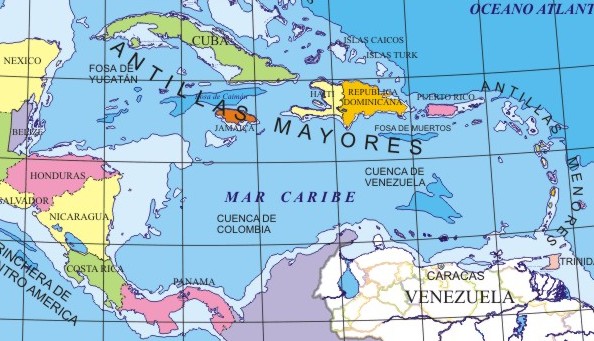|
||||||||||||||||||||||||||
The Caribbean Sea, also known as the Sea of the Antilles, located in the center of the American continent has always been an important protagonist of american history. Since the physical union of the continent in Central America, the have been continuos colonizing migrations of animals and people, the discovery from Europe, the colonial period and subsequent independence until this days has been and always will be the origin of his own destiny.
The Caribbean Sea covers an area of 1019310 Miles2, it is located in the western section of the Atlantic Ocean. To the north it borders whith the Greater Antilles and the Lesser Antilles to the east, Central America to the west and the south with the northern coast of South America. All the dependent countries and territories that have coasts on the shores of the Caribbean Sea are located around it. Those of the North and East section are insular and those of the South and West continental. The predominant language is Spanish but English, French, Dutch and a number of native or mixed indigenous languages are also spoken in some places. The hemispheric location of the Caribbean Sea is below the Tropic of Cancer within the northern intertropical fringe of America. With a pleasant Climate life develops in its most diverse forms, and is only disturbed in some occasions by tropical storms. The average annual temperatures are above 73.4ºF, with oscillations between day and night of up to more than 50ºF. Most days are sunny, some cloudy and in the driest places of the Caribbean area there are very few rainy days throughout the year. The perfect time to visit the Caribbean is during the dry season that corresponds to the months between December and May. The Caribbean Basin is mainly limited by the Teutonic Plate of the Caribbean, which includes the northern coast of South America, Central America and the chain of islands of the Antilles. For historical and cultural reasons, El Salvador, Guatemala, Bahamas and Barbados are also included. The terrestial Geography terestre is very varied both from the topographic and natural point of view. The Nature of the Caribbean Basin is characterized by its biodiversity, both terrestrial and aquatic, developed in a warm and humid environment adecuate for the development of life as we know it. The diversity of biomes is remarkable from the semi-desert to the rain forest, and in some places small patches of cloud forest. There are also many aquatic biomes although and their biodiversity is well recognized as is the case of the coral reefs. With the inclusion of the mangroves, a large area of the coasts of the Caribbean Sea is added to the accuatic biomes. As an extra we can not fail to mention the freshwater systems as the rivers that pour their waters in the sea. All of them, to a greater or lesser degree, contribute to the exuberance of life that lives in the Caribbean Sea. There are many organizations that are studying and monitoring the ecosystems of the Caribbe Sea and there is no doubt that it is up to each one of us to contribute to their conservation and by minimum not contaminating them. Thank You. Several theories have been proposed for the colonization of the American continent. Regardless from where the caribbean Sea was colonized it has been a place of north-south passage, it is possible that in the crossing north-south has been some meetings of different groups of humans. In Central America it developed one of the most mysterious and advanced cultures of the many present in America and even today is giving surprises with the archaeological findings. The normal course of the caribbean History changed dramaticaly after the voyage of Christopher Columbus in 1492, it became an encounter full of surprises for both cultures, although it almost represent the extintion of the american one. The time of the colony was a fight of the european powers in America, with the pepper touch of the pirates who independently or not robbed part of the traffic with Europe, mainly to Spain to whom these waters belonged. Tourism is the main vocation of this region, for its climate that seldom displeases, and has created an environment that encourages to relax the internal tension that you may have. The landscapes of distant horizons where the look is lost in the multicolored sunsets. The light that illuminates everything, sometimes even it dazzle, but wen illuminates the shadows before and after midday, then it's time to go out. The maritime traffic is important not only the mercantile one by the Panama Canal, also by the tourist ships that stops in all the interesting places of these waters. The only difficult thing about the Caribbean Sea is that you get used to it easily and it is hard to leave it, but the caribbean guarantees you that when you want to come back it will be there for you. Geographic location is important, especially to know where you are or where you want to go. The Maps presented here locate you from the most general to the particular to include some aspects of each place. For more details, it flows to the maps of the Caribbean Sea on Google, where high levels of detail and a large amount of photographic information can be achieved. Just to get an idea of how it is already, since the Caribbean network on the Internet is well developed and interconnected.
|
| |||||||||||||||||||||||||







